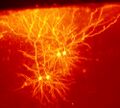Biology:Mouse brain
The mouse brain refers to the brain of Mus musculus. Various brain atlases exist.
For reasons of reproducibility, genetically characterized, stable strains like C57BL/6 were chosen to produce high-resolution images and databases.[1] Well known online resources include:
- Allen Brain Atlas[2]
- Mouse Brain Library[3]
- High resolution mouse brain atlas
- BrainMaps
Despite superficial differences, especially in size and weight, the mouse brain and its function can serve as a powerful animal model for study of human brain diseases or mental disorders (see e.g. Reeler, Chakragati mouse). This is because the genes responsible for building and operating both mouse and human brain are 90% identical.[4] Transgenic mouse lines also allow neuroscientists to specifically target the labeling of certain cell types to probe the neural basis of fundamental processes.[5][6]
Anatomy
The cerebral cortex of a mouse has around 8–14 million neurons while in those humans there are more than 10–15 billion.[7][8] The olfactory bulb volume takes about 2% of the mouse brain by volume in contrast to about 0.01% of the human brain.[9][10]
Mouse cingulate cortex neurons
A biophysically realistic model of the mouse primary motor cortex microcircuit representing a cylindrical volume of 300 μm diameter: 3D visualization, connectivity, dimensions, and neuronal densities, classes, and morphologies[11]
Development
See also
References
- ↑ MacKenzie-Graham, Allan; Jones, Eagle S.; Shattuck, David W.; Dinov, Ivo D.; Bota, Mihail; Toga, Arthur W. (2003). "The Informatics of a C57BL/6J Mouse Brain Atlas". Neuroinformatics (Springer Nature) 1 (4): 397–410. doi:10.1385/ni:1:4:397. ISSN 1539-2791. PMID 15043223.
- ↑ "ISH Data :: Allen Brain Atlas: Mouse Brain". http://mouse.brain-map.org/.
- ↑ "Search the library". 2003-06-05. http://www.mbl.org/.
- ↑ Park, Alice (19 January 2007). "The Brain: What the Mouse Brain Tells Us". Time. http://content.time.com/time/magazine/article/0,9171,1580427,00.html.
- ↑ Gordon, J. W.; Scangos, G. A.; Plotkin, D. J.; Barbosa, J. A.; Ruddle, F. H. (1980-12-01). "Genetic transformation of mouse embryos by microinjection of purified DNA" (in en). Proceedings of the National Academy of Sciences 77 (12): 7380–7384. doi:10.1073/pnas.77.12.7380. ISSN 0027-8424. PMID 6261253. Bibcode: 1980PNAS...77.7380G.
- ↑ Haruyama, Naoto; Cho, Andrew; Kulkarni, Ashok B. (2009). "Overview: Engineering Transgenic Constructs and Mice" (in en). Current Protocols in Cell Biology 42 (1): 19.10.1–19.10.9. doi:10.1002/0471143030.cb1910s42. ISSN 1934-2616. PMID 19283728.
- ↑ "Brain size and intelligence- why a human is smarter than a mouse". 2012-11-13. http://blogs.dnalc.org/2012/11/13/brain-size-and-intelligence-why-a-human-is-smarter-than-a-mouse/.
- ↑ Herculano-Houzel, Suzana; Catania, Kenneth; Manger, Paul R.; Kaas, Jon H. (2015). "Mammalian Brains Are Made of These: A Dataset of the Numbers and Densities of Neuronal and Nonneuronal Cells in the Brain of Glires, Primates, Scandentia, Eulipotyphlans, Afrotherians and Artiodactyls, and Their Relationship with Body Mass". Brain, Behavior and Evolution (S. Karger AG) 86 (3–4): 145–163. doi:10.1159/000437413. ISSN 0006-8977. PMID 26418466.
- ↑ McGann, John P. (2017-05-11). "Poor human olfaction is a 19th-century myth". Science (American Association for the Advancement of Science (AAAS)) 356 (6338): eaam7263. doi:10.1126/science.aam7263. ISSN 0036-8075. PMID 28495701.
- ↑ "Brain Facts and Figures". https://faculty.washington.edu/chudler/facts.html.
- ↑ Dura-Bernal, Salvador; Neymotin, Samuel A.; Suter, Benjamin A.; Dacre, Joshua; Moreira, Joao V.S.; Urdapilleta, Eugenio; Schiemann, Julia; Duguid, Ian et al. (June 2023). "Multiscale model of primary motor cortex circuits predicts in vivo cell-type-specific, behavioral state-dependent dynamics". Cell Reports 42 (6): 112574. doi:10.1016/j.celrep.2023.112574. https://www.cell.com/cell-reports/fulltext/S2211-1247(23)00585-5. Retrieved 21 June 2023.
 |







